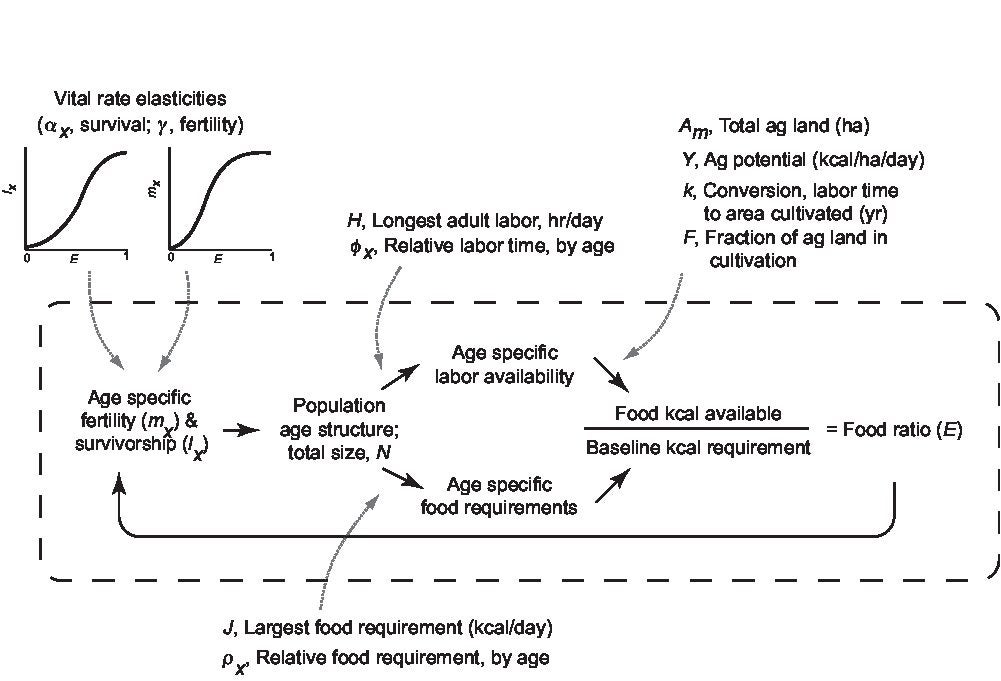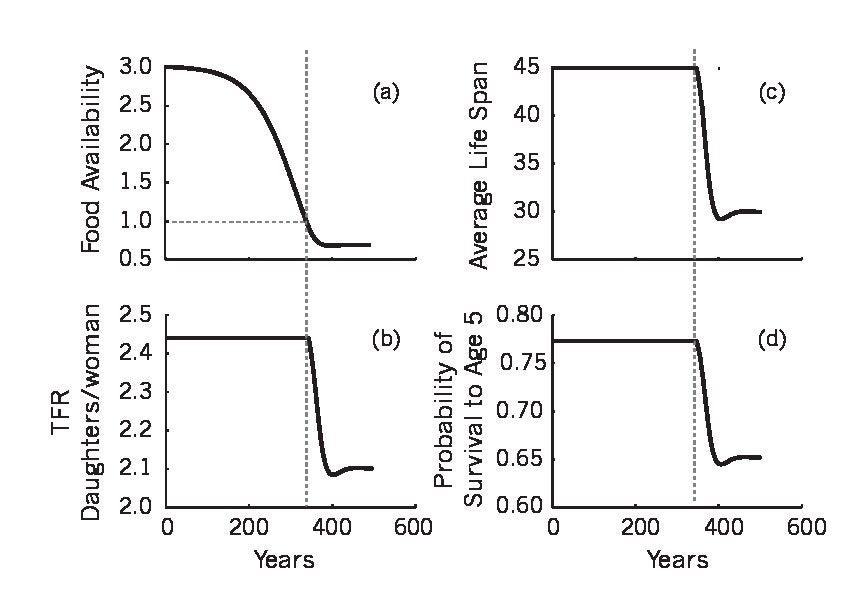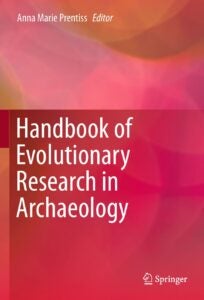Quantitative modeling has been a prominent means of investigating population ecology dynamics since Verhulst (in 1838) first expressed the intuitions of Malthus (1798) in mathematical form. Cedric Puleston and I have been collaborating on efforts to make such models more realistic and more directly relevant to issues of human prehistory and socio-economic development. This page features examples from four of our publications (citations following). Work supported by the National Science Foundation (Human Systems Dynamics, Collaborative Research, Proposal# 0827275)

Model components and their causal connections (solid arrows) are within the dashed line rectangle; demographic, biosocial, and agro-ecological factors determining the values assigned to those core components are shown around the circumference, dotted arrows indicating their point of action. Reading from center left, population age structure determines both agricultural labor availability and food requirements, agro-ecological factors such as land availability determine food production relative to requirements, the resulting "food ratio" then acts through age specific mortality and fertility to determine the next generation population structure (Puleston and Winterhalder 2019: 316, Fig 16.1).

As population grows food availability declines smoothly and slowly, from a 3x surplus to just enough (E = 1) at year 347, to a 0.67 deficit as the population stabilizes 51 years later. Quality of life plummets abruptly as food shortfalls emerge: (B) total fertility rate from 2.44 to replacement, 2.10; (C) average life span from 45 to 30 years; and (D) the probability of a youth surviving to age five from 0.773 to 0.652 (Puleston, Tuljapurkar and Winterhalder (2014: e87541, Figure 3)).
In a subsequent publication titled “Production risk, inter-annual food storage by households and population-level consequences in seasonal prehistoric agrarian societies,” we and co-author Cody Ross used an adaptation of the model to examine the effectiveness of adaptations to the risk of crop failure. We found that household-level, risk-sensitive adaption to unpredictable environmental variation in annual agricultural yields is an incentive to produce a surplus for inter-annual storage against future shortfalls. It can be quite an effective mechanism over long periods, however, storage also can be a trap. It can underwrite population growth to elevated levels that are susceptible to catastrophic multi-year famine events that exhaust food stores. Greater environmental variation and higher levels of fixed set-asides such as seed requirements or tax obligations to political authorities also can lead to more severe, periodic famines (Winterhalder, Puleston and Ross (2015)).
Our next contribution addressed the population ecology of taxation in early agrarian state-level societies. The Abstract: “We adopt an imagined exchequer, the functionary responsible in an early polity for securing resources from its agrarian subjects, and we develop a feature-rich demographic and environmental model to explore the population ecology of agricultural production in the context of population growth, Malthusian constraints and economic exploitation. The model system allows us to (i) identify and characterize a peak of surplus production early in population growth, prior to density-dependent constraints and (ii) characterize the taxation potential of a population at its Malthusian equilibrium. For a fixed total level of taxation the exchequer has two options: a small population taxed at a high rate, unstable to small perturbations, or a larger population taxed at a lower rate, which is stable. In a small and growing population it is more effective to tax goods; as the population approaches its density-dependent equilibrium it becomes more effective to tax labor. We likewise show that heavily taxed early agrarian states face an extinction risk dependent on the level of taxation and magnitude of yield variation. Successful agrarian states balanced resource exploitation against dynamic population ecology constraints; we propose that fiscal mismanagement should be among the hypotheses for polity failure (Winterhalder and Puleston 2018).
Finally, in 2019 we published a a general review of these and related population ecology models in a volume edited by archaeologist Anna Prentiss, and titled, Handbook of Evolutionary Research in Archaeology.

Citations
